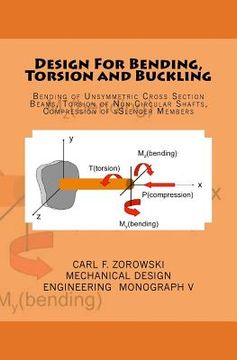Share
Design for Bending, Torsion and Buckling (in English)
Carl F. Zorowski
(Author)
·
Createspace Independent Publishing Platform
· Paperback
Design for Bending, Torsion and Buckling (in English) - Zorowski, Carl F.
$ 9.60
$ 12.00
You save: $ 2.40
Choose the list to add your product or create one New List
✓ Product added successfully to the Wishlist.
Go to My WishlistsIt will be shipped from our warehouse between
Thursday, July 11 and
Friday, July 12.
You will receive it anywhere in United States between 1 and 3 business days after shipment.
Synopsis "Design for Bending, Torsion and Buckling (in English)"
Design Monograph V deals with predicting the internal stress states created by bending, torsion and buckling deformation behavior. In addition to presenting classical solution models applicable to simple geometries and loadings the content is expanded to cover more complex circumstances not always covered in standard texts on the subject. Chapter 1 of Design for Bending begins with the classic "simple beam theory" model that predicts a linear internal normal bending stress distribution that balances the bending moment at that location. However, it is only applicable to a beam whose cross section possesses an axis of symmetry. This model is generalized to apply to beams possessing any general cross section geometry with no restriction on how the loading is applied. In Chapter 2 advantage of the area properties about rotated axes in the cross-section permit a simplification of the general stress formulation. This leads to a convenient method of determining the neutral axis of bending and the location and magnitude of the maximum stress. Chapter 3 presents two numerical examples that demonstrate the application of this procedure to a specific right angle and z cross section beams. The results are compared to stress values calculated using the simple beam model formula. Chapter 1 of Design for Torsion begins with the classic model for determining the maximum shear stress and unit twist in a solid or hollow circular shaft subjected to an applied torque. An approximate solution a rectangular cross section is presented by analysis of a pressurized membrane as an analogy to the theory of elasticity formulation. The thin rectangular section solution is adapted to solve numerically the torsional behavior of an extruded H section shaft. In Chapter 2 the membrane analogy is used to solve the problem of a hollow non-circular cross section shaft. This gives rise to several simple formulae in which the wall thickness is constant. Comparisons are included of different geometries that either contain the same amount of material, posses the same cross section circumferential length or are slit along the length of the shaft. A general solution and numerical example for a two-cell system is formulated and solved for the internal stresses. Chapter 3 deals with the numerical solution of a practical problem in which a convoluted thin walled cross section tube design is proposed to provide greater torsional flexibility in a gas tight connection between two tanks. Chapter 1 of Design for Buckling solves the problem of the lateral bending of a slender fixed-free column subjected to an axial compressive load applied with eccentricity to the centroid of its cross section. This leads to the classic Euler Buckling Load defining the maximum compressive load that can be applied before undefined lateral instability occurs. In Chapter 2 the Euler buckling is determined for the three remaining classic column support conditions i.e. a pined-pined, pined- fixed and fixed-fixed end restraints. Chapter 3 deals with the effects of cross sectional geometry and material properties on the buckling behavior. This permits establishing a design criterion between short and long columns. Numerical examples are demonstrated for steel and aluminum. Chapter 4 develops a general formula for the amount of vertical end movement in terms of maximum lateral displacement and deflected shape of the column. The lateral bending behavior of a thin plastic ruler in a buckling experiment is used to illustrate this phenomenon. In Chapter 5 the previous materials are used to solve the redesign of an existing temperature activated switch whose operation involves both buckling and lateral displacement behavior.
- 0% (0)
- 0% (0)
- 0% (0)
- 0% (0)
- 0% (0)
All books in our catalog are Original.
The book is written in English.
The binding of this edition is Paperback.
✓ Producto agregado correctamente al carro, Ir a Pagar.

